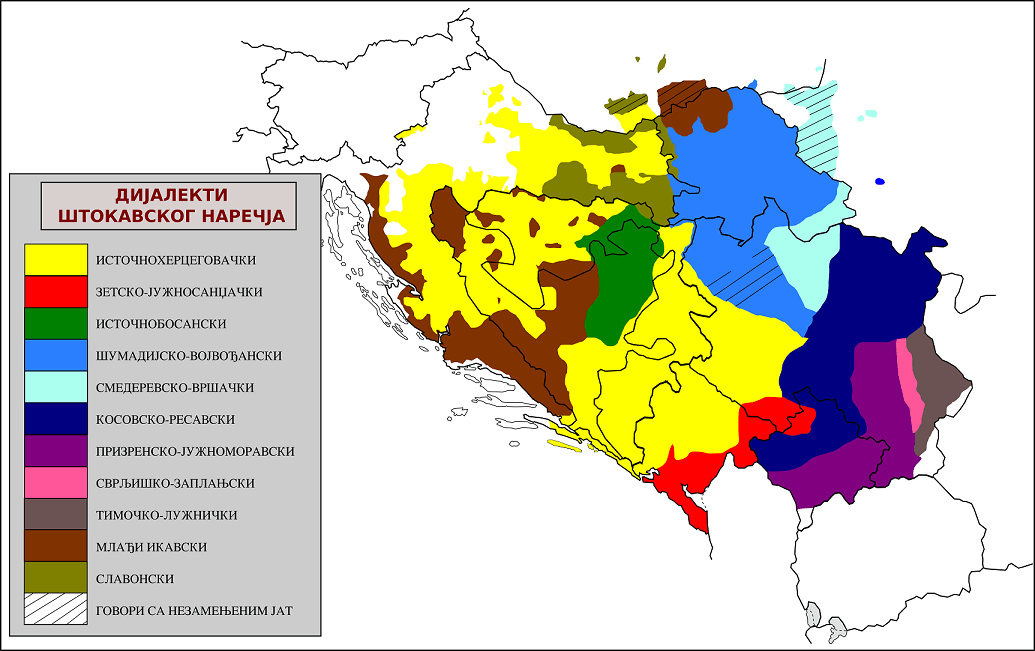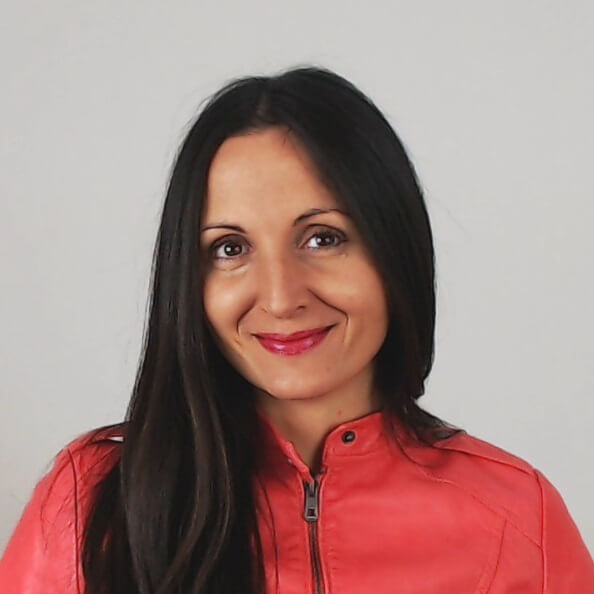How Similar Are Serbian and Croatian:
7 Biggest Serbian and Croatian Language Differences and Which Language is Good for You to Learn
Many people wonder if Serbian and Croatian are the same language. If not, how different are they? And what’s the difference? How they relate to Bosnian and Montenegrin? Which one you should learn?
Serbian, Croatian Bosnian or Montenegrin: our language
There is one word that describes the relation between Serbian and Croatian with Bosnian and Montenegrin languages perfectly: NAŠKI (pronounced: nashkee). It is coined from the possessive pronoun NAŠ (ours) and the suffix -SKI that we use for making adverbs. You’ll recognize it in the names of the languages: srpski, hrvatski, engleski, norveški, italijanski (Cro. talijanski), španski (Cro. španjolski).
The term “naški” or “naš jezik” (our language) is used mainly by the people living in diaspora, where all the mentioned nations stick together. Out there, they feel the need to diminish the differences among them. That’s why they differentiate between the person who speaks “our language” (On govori naški) and the person who speaks, for example, Czech (On govori češki). A person who speaks “naški” is someone you can speak your own language with.
Imagine that there were a Serb from Belgrade, a Croat from Zagreb, a Bosnian from Sarajevo and a Montenegrin from Podgorica in one room. What do you think, how would they communicate? Do you think they would need an interpreter, or maybe several interpreters? No. They could pick an argument, each one of them in their own languages. And they would understand each other perfectly. Just like four people four people from USA, UK, South Africa and Australia would.
That is in fact how we speak, as I explained in this post.
There is a Facebook group called “Naš jezik” (our language) that gathers linguists and commoners from our region. I really enjoy being part of this group. We discuss serious linguistic matters, have fun, spread tolerance – but often also joke mercilessly.
Hopefully, this gives you the idea of how similar the languages are. “Language” is a political, and not a linguistic category. As someone once said: “A language is a dialect with an army and navy”. Montenegrin, Bosnian, Serbian and Croatian are considered languages because of politics, and not for linguistic reasons.
Why are Serbian, Croatian, Bosnian and Montenegrin (almost) the same?
In fact, all four languages have based their standards on the same dialect – the Shtokavian dialect (štokavski, штокавски). The name is derived from the word we use for what: što or šta. They are even based on the same subdialect: Eastern Herzegovinian (istočnohercegovački) – marked yellow in the picture below. In addition, the Serbian standard assimilated another subdialect: Shumadinian-Voivodinian (šumadijsko-vojvođanski) – marked blue in the picture.

Image from Wikipedia: Shtokavian subdialects according to Pavle Ivić (1988)
The conclusion is: weather you learn Bosnian, Montenegrin, Serbian or Croatian, you will be able to communicate across all the four countries. The vast majority of the words are the same, or incredibly similar. Conjugations and declensions are the same.
Why you should start with Serbian or Croatian (and not Bosnian or Montenegrin)
You may wonder why am I not going to speak about Bosnian and Montenegrin. Because I wouldn’t suggest starting with none of them. And I’ll explain why: Montenegrin and Bosnian are the newest languages. Therefore, resources available for them are quite scarce and undeveloped. Bosnian standard partly conforms with Croatian and partly with Serbian. Its main distinction is more Turkish loanwords in the standard vocabulary.
On the other hand, Serbian and Croatian already have a long tradition in being taught to foreigners, starting as Serbo-Croatian. Consequently, there are more quality books available.
Having explained all this, we can now focus on the most notable differences between Serbian and Croatian. I will also present the advantages they offer to the learners. My goal is to help you understand the differences and decide which one of the two languages to learn – or to start with.
The Biggest Differences between Serbian and Croatian
Difference #1: The Melody of Speech in Serbian and Croatian, Bosnian and Montenegrin
The most notable difference lies in the melody of speech. All of us in the four countries recognize intuitively. That’s how we can distinguish if someone is coming from another country, or even region or town in the same country. It’s impossible to explain this in writing and I will leave it to your ears. Try watching to the national televisions or listening to the national radio stations to catch the nuances of different accents, and maybe even deciding on your favorite. It will probably be easier to hear once your an intermediate Serbian or Croatian speaker.
If you’re advanced, I suggest you to watch this excellent video: a young man from Serbia imitates different accents from EX YU (that’s short for Former Yugoslavia). He’s incredibly good at that, as you can read in the comments.
There are two videos you can watch to try and hear the difference between Serbian and Croatian pronunciations.
- In this video you can hear a Croatian musician Tony Cetinski (on your left) and a Serbian musician Željko Joksimović (on your right). They are interviewed about a song they recorded together (the interviewer speaks Serbian).
- In this video you can watch a popular Croatian singer Severina interviewed by a Serbian journalist for a Serbian TV. From the minute 7.25 you can even hear a song she sings in Ikavian, a dialect typical for her hometown Split in Dalmatia.
Difference #2: The Yat Reflexes – Ijekavian, Ekavian, Ikavian
Yat (ѣ) was a common Slavic long vowel, that in Eastern-Herzegovinian was replaced with -je- or -ije-, producing the pronunciation that we call “ijekavica”, while in Shumadinian-Voivodinian it was replaced with -e-, giving the pronunciation that we call “ekavica”. That’s what makes the difference between ijekavian and ekavian: “ovdje” and “ovde”, “mlijeko” and “mleko”, “djevojka” and “devojka”.
Both subdialects have several ikavian Yat reflexes: that’s why we have nisam and they say nijesam in Montenegro. That’s also why we have htio and smio from the verbs htjeti and smjeti in ijekavian.
The Serbian standard allows both pronunciations. Both are given an equal importance in our official orthography and grammar books. However, ekavian is widespread in Serbia; virtually only people originating from Bosnia, Croatia or Montenegro speak ijekavian here. On the other hand, everyone in Republika Srpska speaks ijekavian. In Croatia and Bosnia only ijekavian forms the standard.
Conclusion: If you decide to learn Serbian (first), your teacher and your books will probably teach you ekavian. And that’s good because it is somewhat easier to pronounce and you don’t have to remember where to put -e-, where -je- and where -ije-.
For example, this is how we decline the word time in ekavian: vreme, vremena; and in ijekavian: vrijeme, vremena
However, if you want to learn both Serbian and Croatian, you should consider starting with the latter. Because it might be slightly more difficult to remember where to put e/je/ije after you’ve accustomed to the simple e in ekavian.
For more information about Yat, You can refer to this article on Wikipedia.
Difference #3: Double Conjugation in Serbian vs Infinitives in Croatian
People in Croatia tend to use infinitives to complement modal, semi-modal or phasal verbs, for example: “ja hoću raditi”, “ti možeš doći”, “on želi učiti”, “mi volimo plivati”, “oni su počeli pričati”.
On the other hand, in Serbia people prefer to double conjugate: “ja hoću da radim”, “ti možeš da dođeš”, “on želi da uči”, “mi volimo da plivamo”, “oni su počeli da pričaju”. But using infinitives is also legitimate, especially when there are to many conjunctions “da” accumulated.
In Croatia, the extensive use of the conjunction “da” is referred to with the scornful term “dakanje”.
Using infinitives is a feature typical for Slavic languages, while double conjugating is considered a Balkan languages common feature.
Conclusion: For a Romance, Germanic and even Slavic language speaker, using infinitives will be very convenient and probably easier to pick up. However, double conjugation is an excellent brain-empowering exercise. Especially when you have to combine two verbs from different groups, such as:
ja volim da putujem
ti voliš da putuješ
on voli da putuje
mi volimo da putujemo
vi volite da putujete
oni vole da putuju
Quite challenging, isn’t it?
Difference #4: The Future Tense
In both standards, the future tense is the same: made from the model verb “hteti” (mostly its short or enclitic forms) and infinitive of the verb we want to use.
Ja ću ići. Ja ću raditi. Ja ću jesti.
If we omit the pronoun, we’ll have the future tense in inversion. The verbs in –ći are the same here. There is a slight difference only in the verbs with infinitive ending in –ti.
So in Serbian we have: Ići ću. Radiću. Ješću.
And in Croatian we have: Ići ću. Radit ću. Jest ću.
In colloquial speech in Serbia it is very common to use da+present instead of infinitives in the future tense, which is typical for the Balkan Sprachbund. So we have another variant of the future tense: Ja ću da idem. Ja ću da radim. Ja ću da jedem.
In some parts of Croatia (including Zagreb), under the influence of the Kajkavian dialect, they use the Slavic future tense. It is compound of the perfect forms of verb to be (budem), but shortened (bum), and the participle that is also used for the past tense: Bum išel/išla. Bum radil/radila. Bum jel/jela.
Conclusion: The future tense is quite complex. You’ll need to learn to recognize it in all its various forms, in both languages. For your speaking, one form will suffice. Learn to use the basic standard form and only recognize the other forms in the beginning. The word order can also be tricky here, especially in elaborate sentences. Focus on noticing the parts of it, as they can be scattered around the sentence.
Difference #5: Vocabulary or Lexicon – Words Typical for a Region
Even though the vast majority of the words are exactly the same or slightly different, there are quite a few differences in vocabulary. Nonetheless, they are understood by both sides. We all mostly know all the variants, and we just use the one normally used in our region.
In this excellent Croatian dictionary, you’ll find many words marked as reg. (regional) and srp. (Serbian). Still, they are used.
For educative purpose, we can group the different words into five categories.
- Some of those words are just regionally colored, such as: Serbian greeting “zdravo” and Croatian “bog”, or “hleb/hljeb” vs “kruh”, “voz” vs “vlak” etc.
- Other words are different because Serbs took a foreign word and Croats coined their own word: pasoš / putovnica; avion / zrakoplov; aerodrom / zračna luka.
- Sometimes the words are developed from the same stem with a different ending: studentkinja/studentica; sportista/sportaš; lekar/lječnik. However, the same stems and endings are used in both Serbian and Croatian languages. It’s just the specific combination of a stem with an ending that is typical for a region.
- Sometimes different stems are chosen for deriving a word. There is this famous, funny and illustrative example: in Serbian house is “kuća” and housewife is “domaćica”; in Croatian “kuća” is “dom” and “domaćica” is “kućanica”. (Of course, both “kuća” and “dom” are used in both languages.)
- In some cases Serbian loaned a foreign word while Croatian preserved the Slavic word. That’s how we use the Greek word “hiljada” for “a thousand” in Serbian, while the Slavic word “tisuća” is kept in Croatian. This also explains the different names of the months: the international names are adopted in Serbian, while the old Slavic words are kept in Croatian:
Meseci u srpskom: januar, februar, mart, april, maj, jun, jul, avgust, septembar, oktobar, novembar, decembar
Mjeseci u hrvatskom: siječanj, veljača, ožujak, travanj, svibanj, lipanj, srpanj, kolovoz, rujan, listopad, studeni, prosinac
Conclusion: If you prefer an easier way, then your choice here will definitely be Serbian, because it has more international loanwords. That allows you to quickly enrich your vocabulary and your ability to express yourself.
Difference #6: Deriving Verbs With Different Suffixes
Both languages still use many loan words, and derive verbs from them. This applies to the Latin and Greek international heritage and also to the new technology-related English terms, that have flooded every language. Generally speaking, the suffix -irati (essentially Latin borrowed through German) seems to be the most productive (i.e. makes the most verbs) in Croatian. On the other hand, the Slavic suffix -ovati and the suffix -isati of Greek origin are preferred in Serbia.
However, there are words that come only in -ovati pattern. Please refer to the table bellow for the examples. (In rows with only one word, it is the only form and used in both countries.)
| Serbian -ovati | Serbian -isati | Croatian -irati |
| Interesovati | Interesirati | |
| Organizovati | Organizirati | |
| Recitovati | Recitirati | |
| Deklamovati | Deklamirati | |
| Fotografisati | Fotografirati | |
| Kontrolisati | Kontrolirati | |
| Kanalisati | Kanalizirati | |
| Parkirati | ||
| Analizirati | ||
| Paradirati | ||
| Marširati | ||
| Skenirati | ||
| Modelovati | Modelirati |
Conclusion: If you prefer an easy way, then your choice here will definitely be Croatian. It’s obviously easier to learn foreign verbs if they follow the same pattern. However, if you prefer diversity over simplicity, have a go on the Serbian jolly suffixes.
Difference #7: Pronunciation of the tricky sounds
I’m referring here to the sounds represented by the letters Č, Ć, Dž and Đ. These sounds are clearly and strongly distinguished only in Serbia and Montenegro. The majority of Croats and Bosnians make no difference between Č and Ć, nor between DŽ and Đ. (Explanation how to pronounce C, Č and Ć can be found here.)
The difference between these sounds is very difficult to hear for a non-native. So it’s easy to give up trying to learn them. However, it’s very difficult to know what letter you should write in a word if you do not distinguish the sounds. If you read random comments on the internet, you’ll see that many Croats and Bosnians confuse the letters together with the sounds.
Luckily, there are very few examples where confusing these sounds can cause a misunderstanding. On the internet and text messages, many people even write “ošišana latinica” (“haircut Latin script”) and survive. (“Ošišana latinica” is the term for writing Serbian in Latin script without the diacritical signs – the little strokes above the letters č, ć, š, ž.)
Conclusion: Whether you choose Serbian or Croatian, try to learn the tricky sounds as much as you can. If it’s difficult for you to hear the difference, that’s probably because you don’t have similar sounds in your language. At least, try to remember how the words are written. But don’t take that too seriously. Even if you make a mistake, everyone will understand you.
Choose your language: Should you learn Serbian or Croatian?
This is the question only you can answer for yourself. I will give you a few things to consider when making your decision.
1) Do you have friends or family from Croatia or Serbia? If you do, choose the language you can speak with more people you know.
2) Do you travel to Serbia or Croatia? If you do, choose the language of the country you’ll travel to more often.
By all means, you should first learn the language of the country you have the most friends in or where you travel the most often ‒ that’s the most sensible choice. But what if you have and equal number of friends from Serbia and Croatia and travel equally often to both countries?
3) Then, take a look at the differences I explained, listen to the two languages, and pick your favorite.
After you’ve mastered the language of your choice, you will easily get acquainted with the other existing variants. You will learn Serbian and Croatian, and many different dialects or accents of the region. It will be a great source of fun. And you’ll enjoy it, I promise!
by Magdalena Petrovic Jelic
Founder of Serbonika
Serbian language teacher and entrepreneur, language lover and polyglot, but also a mother and a relentless storyteller. Read more about me.
My mission is to create the best method for learning Serbian. Would you like to learn Serbian with my lessons? Try free.
Serbonika
Najbolja metoda za učenje srpskog jezika
The best method to learn Serbian
The sooner you start learning, the sooner you’ll start talking. Take action now!
All Shapes of the Future Tense in Serbian and Croatian Language
So many forms to express the future tense in Serbo-Croatian! What are all of them and how to make sense? Read on to learn all shapes of the future tense in Serbian and Croatian.
All differences between will and want in Serbian: hteti i želeti
If you’re puzzled about the verbs will and want in Serbian (hteti i želeti), unsure when to use which, that’s common. Let’s learn all their differences and similarities to clear up the confusion.
Feet Speech: 8 Serbian Leg Idioms for English and Norweigian Speakers
Did you know that many Serbian leg idioms are actually the same in English and Norwegian? That was a surprise for me too!



